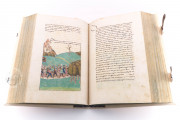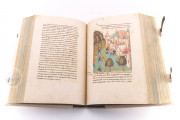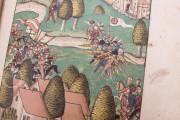The Great Burgundian Chronicle, also called the Zürcher Schilling after the city where it is kept, is the most original and comprehensive reference book on the Burgundian Wars. It was executed around 1480 in the tradition of the Bern chronicles begun by Konrad Justinger in 1420 and carried on by Bendicht Tschachtlan around 1470.
Diebold Schilling the Elder is both the author and writer of this fascinating work. The Great Burgundian Chronicle with its 199 lavish illustrations represents an impressive testimony to the history of Bern and the Swiss Confederation.
Diebold Schilling the Elder
In 1460 Schilling the Elder entered the services of the Chancellery of Bern. Before he had been working in Lucerne, but left the position as a scribe to his brother Hans, father of Diebold Schilling the Younger and author of the Lucerne Chronicle.
Here, Schilling the Elder gained first insights into the administration and jurisdiction of a city as well as into the implications of external affairs experienced by one estate of the Old Confederation. In Bern he climbed the career ladder. From 1468 he was a member of the Great Council.
In addition he was also active as a judge. He was entrusted with several delicate missions and also participated personally in the Burgundian Wars. As a citizen of Bern, he also got to know Bendicht Tschachtlan, the then leading chronicler of the city. Diebold Schilling the Elder died in 1486.
The Great Burgundian Chronicle
In 1474 Schilling was commissioned by the Council of Bern to write a chronicle of the city, from its beginnings to contemporary times. Considering the greatness and importance of his home city, Schilling understood this task in creating a work of major significance.
Between 1474 and 1483, he created a monumental work, the Official Chronicle of Bern in three volumes. The original version of the third part, our Great Burgundian Chronicle, never left Schilling’s possession. It is the most comprehensive of all chronicles ever carried out by Schilling.
The Great Burgundian Chronicle gives a unique witness; here we see very clearly the genuine understanding of a patriot. The official edition of the third volume was censored in several places.
However, passages eradicated from the official text not only included important political events but also a story about a trial about June bugs which only the Burgundian Chronicle still recounts and which, according to Schilling, is rather amusing to hear.
In 1478 a parish priest in Bern had proclaimed from the pulpit that he would summon the insects before the bishop of Lausanne, if the dreadful June bugs plague did not stop within six days.
The Text: A Monument to History
The 429 chapters of the Great Burgundian Chronicle do not deal with history in the present meaning of the word. Schilling puts little emphasis on background information, but rather describes historical events.
In each of his chapters, something important is going on: war, plundering, sieges, robbery and manslaughter, trials and violence. All these events are not only vividly described but also made visible in colourful illustrations.
Schilling’s beautiful and regular hand writing, a Gothic Cursive Script with sweeping initials, is accompanied by 199 of his own pen drawings which were washed in water-color by another artist.
The Pictorial Decoration: Luxury of the Middle Ages
One of the most important features of these illustrations is without any doubt the landscape in which the events take place. However, it hardly ever corresponds to topographic reality but is rather based on the artist’s imagination.
The viewer sees the depicted scenes from above, little towns, villages and castles, all carefully inserted into a lovely landscape of beautifully rolling hills. The narrative manner in which the artist represents the entire history of the Burgundian Wars, is particularly charming.
Almost every event mentioned in the text, down to the most minute detail, appears in his drawings or paintings which depict sieges, skirmishes and the life in soldiers’ camps. Much blood flows in the battles, there are Burgundian cavaliers pierced by the spears of the Confederation’s soldiers, there are horses falling down.
While idyllic scenes stay in the background, war scenes dominate the book. In general, the decoration of the Burgundian Chronicle displays an extraordinary charm, partly due to the naive realism of its illustrations, partly to the lighthearted glorification of heroes and events.
We have 1 facsimile edition of the manuscript "Great Burgundian Chronicle by Diebold Schilling of Bern": Große Burgunderchronik des Diebold Schilling von Bern facsimile edition, published by Faksimile Verlag, 1981
Request Info / Price



















